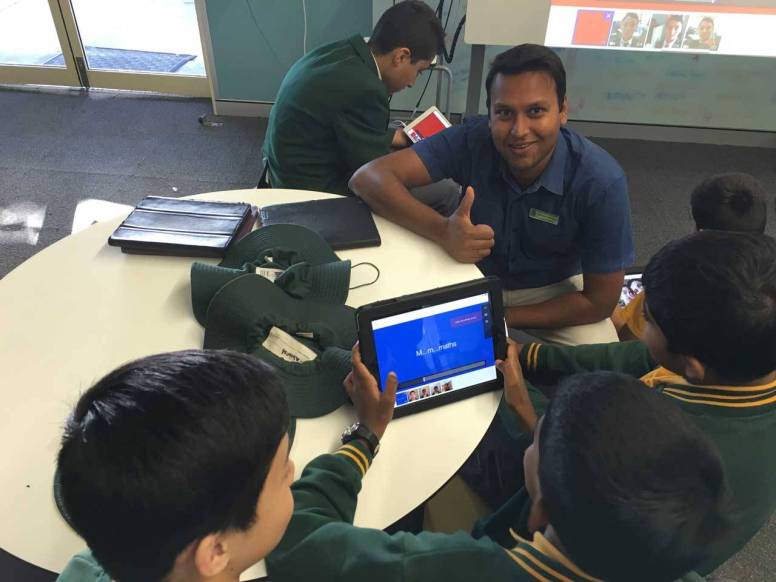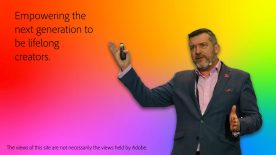Creativity in the Curriculum
I am occasionally told by well-meaning educators that modern information & communications technologies like Adobe tools are fun to use and great to have, but there is very little time in a crowded curriculum to teach or use them effectively. This saddens me because it reflects an old mindset that education is about content delivery. I much prefer educators see their job as making people better people and empowering them with the skills and passion to be lifelong creative learners and effective contributors to society.

Developing Creative Thinkers
In a webinar Adobe Education did with Mitch Resnick from MIT (Massachusetts Institute of Technology) he said learning should be about giving students the opportunity to use new materials to design, create and develop as creative thinkers (see the whole webinar via bit.ly/mitchresnick-adobe14).

Mitch Resnick has continued the great work of Seymour Papert, who I consider the Godfather of ICT integration in education. He heads up the Lifelong Kindergarten group at the MIT Media Lab. Mitch also said in the webinar that success in the future – for individuals, for communities, for companies, for nations as a whole – will be based not on what we know or how much we know, but on our ability to think and act creatively. He said, learning should be about giving students the opportunity to use new materials to design, create and develop as creative thinkers.
Australian Curriculum Links
Digital creativity is a fundamental part of the Australian Curriculum (AC). Within the AC, Critical and Creative Thinking as well as ICT Capability sit alongside Literacy and Numeracy as core general capabilities that are expected to be taught and assessed throughout Australia. Central to these general capabilities, is the statement derived from The (2008) Melbourne Declaration on Education Goals for Young Australians, that all young Australians become successful learners – confident and creative individuals – active and informed citizens.

The teaching of literacy and numeracy skills is important, but not at the expense of the other general capabilities. In an interview Adobe did with Sir Ken Robinson he said that the school curriculum is often narrowed to certain disciplines that are thought to be more useful and it is dominated by standardized testing. In his famous 2006 TED Talk titled Do Schools Kill Creativity?, Sir Ken challenged educators to really think about why we teach mathematics each day at the expense of other curriculum areas.
Multimodal Text
The term multimodal text is found throughout the Australian English Curriculum as well as in other subjects. In the AC, it’s defined as combination of two or more communication modes such as print, image and spoken text, as in film or computer presentations. Examples of multimodal text include slide presentations, animation, book trailers, digital storytelling, live action film making, music videos and various web texts and social media (http://creatingmultimodaltexts.com). I suggest that the focus of multimodal text in the AC is to encourage teachers to allow students to use the modern 21st century tools available to them to construct their learning in a multitude of creative ways.

Adobe has a wide range of digital creativity tools from simple to use free software such as the Adobe Spark applications (https://spark.adobe.com/) to the power of professional tools such as Photoshop, Illustrator, InDesign and Premiere Pro. Most school are using Adobe tools in some capacity, in many cases it is just in the senior Arts/Media subjects. As I travel to schools and universities around Australasia, I’m seeing an increase of our tools being used across a wide variety of subject areas.

A Year 8 student recently thanked me for showing his class how to work with Adobe Spark Video, he said he was tired of being told to use PowerPoint to do her presentations, a product he has been using since early primary schooling. When I asked his teacher why this was the case, she said it was because PowerPoint was the only tool she was confident to be able to help her students with if they got stuck. Many teachers like to be in control of every aspect of what is happening in their classrooms, often to the detriment of creativity, engagement and learning.
Teachers can get help and inspiration with how to work with the wide range of Adobe solutions in their classrooms through the Adobe Education Exchange, which now has over 300,000 members. Students should bookmark the Adobe Help & Support site (https://helpx.adobe.com/) for access to getting started resources as well as advanced tutorials.
Creativity Myths Busted
In his book, Creative Schools: Revolutionizing Education from the Ground Up, Sir Ken Robinson tries to bust a range of myths associated with creativity. The first is that only special people are creative. He responds to this myth by saying that we all have creative capacities and that creativity draws from many powers that we all have by virtue of being human. The second is that creativity is just about The Arts. On the contrary, Sir Ken says that creativity is possible in all areas of life including science, mathematics, technology, cuisine, teaching, politics, business and more. The third myth is that creativity is based around uninhibited self-expression. Sir Ken says this is not the case because creativity often requires deep factual knowledge, great discipline and high levels of practical skill.

Allowing students to work with Adobe software to construct and present their learning can not only enhance creative experiences, it can also improve students engagement and lead to higher levels of learning.
See
Adobe Tools in the Curriculum Part 1
